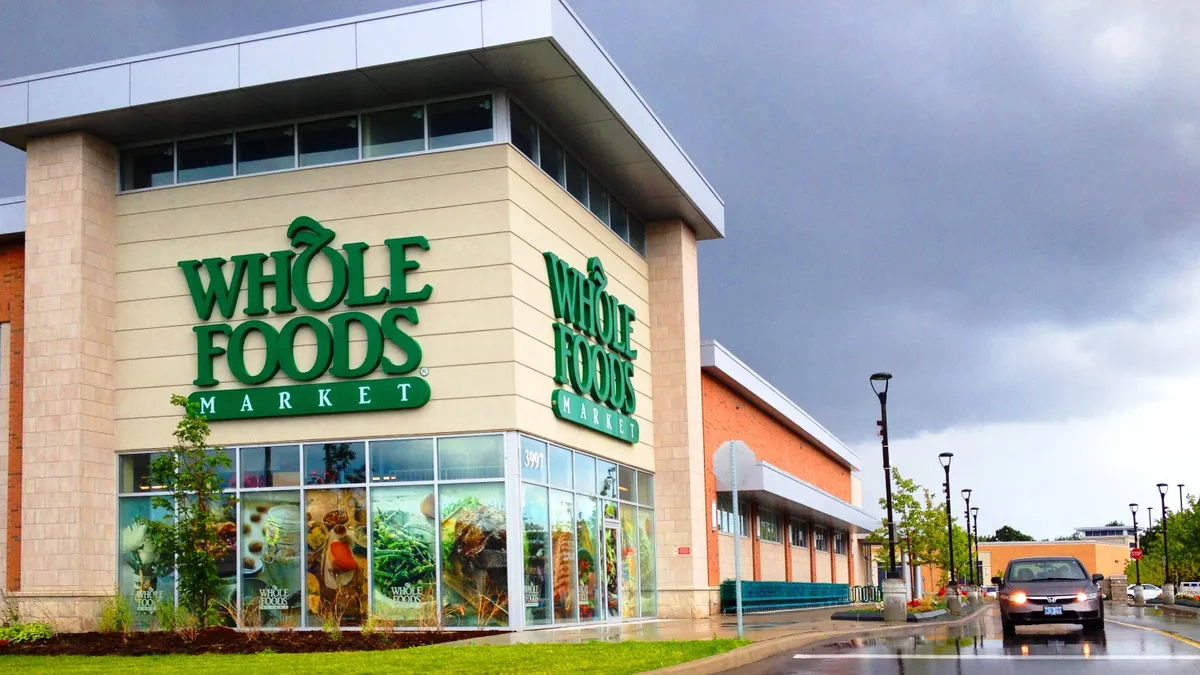Dive Brief:
- One year after Amazon took over Whole Foods, sales and traffic are up slightly, according to reports. Yahoo Finance, citing data from Second Measure, noted sales have increased in the low single digits since the acquisition. Traffic has risen about 3% each quarter since Amazon took control, Thasos data cited by The Wall Street Journal back in June shows.
- Amazon has continued to centralize Whole Foods’ operations — an initiative kicked off by the grocer prior to the acquisition — in order to standardize the supply chain and lower costs. The e-tailer has also rolled out numerous Prime loyalty promotions in an effort to drive shoppers to stores and boost signups for the popular service. In June, 41% of Whole Foods’ new customers were Prime members compared to 34% one year prior, Yahoo Finance noted.
- Reports also note Whole Foods’ prices remain well above industry averages despite Prime discounts and promises that the grocer would remake its “Whole Paycheck” image. An analysis by Morgan Stanley analysts in July found Whole Foods was 13% more expensive than a traditional grocery store based on a spot check of 60 items. Year-over-year, the firm found Whole Foods sales to be just 2% lower than the year before.
Dive Insight:
Whole Foods’ very modest traffic and sales growth may not look like the industry domination many predicted, but it nevertheless counts as a victory. Flashback to a little over a year ago, and the nation’s leading specialty grocer was on the ropes, with comp sales sliding quarter after quarter while stakeholders, including an activist investor, were growing increasingly restless.
So what’s changed in the 12 months since Amazon officially took over? On the surface, not that much. Stores look roughly the same and stock most of the same products that shoppers have long counted on. The most noticeable difference is Amazon Prime, the massive membership program that’s been unleashed at Whole Foods, offering store discounts, a cash-back credit card, savings on online orders and more.
Look past all those bright yellow and blue Prime stickers that dot each store and it’s clear significant changes are underway. The grocer began centralizing its buying operations at its Austin, Texas headquarters before being acquired, and that has continued under Amazon, which values the supply chain efficiencies that flow out of such an effort. Whole Foods has also imposed merchandising fees and cut ties with many small suppliers, shifting the chain’s focus primarily towards large and scalable brands. Reports note, too, that Amazon is trying to relax Whole Foods’ natural sourcing standards to allow products with artificial sweeteners and flavors, such as Coca-Cola.
All of these efforts are aimed at lowering costs and bringing in more customers. But they also create a mainstreaming effect that could dilute Whole Foods’ carefully crafted brand. Will consumers still want to shop at Whole Foods if it offers the same assortment as traditional grocers? The gap between conventional and specialty grocers continues to narrow as chains offer more natural and organic selections. Kroger and Albertsons, for example, have both pumped up their specialty private label and local sourcing efforts in recent months.
Of course, if Amazon can offer the most compelling online shopping experience around, then drifting mainstream may not matter. Whole Foods offers same-day delivery, which includes free two-hour service for Prime members, from a handful of markets, and earlier this month kicked off store pickup that makes orders available in as little as half an hour.
While Whole Foods’ changes under Amazon have been modest, the rest of the industry has undergone a seismic shift. Across the country, grocers have rushed to put online shopping platforms in place. They’ve rolled out new loyalty programs, accelerated their store remodels, partnered with meal kit companies and rolled out mobile apps and other new technologies. Some of these initiatives were already in the pipeline for companies, and reflect a very competitive, over-stored industry. But Amazon’s entry fast-tracked everything.
It’s worth pointing out what many news sources have recently — that Whole Foods and Amazon combine for a tiny sliver of total grocery sales in the U.S. Indeed, Amazon may never be a dominant force in the grocery industry, but it has been the wake-up call that many grocers, which have been slow to respond to consumer demands, needed.









